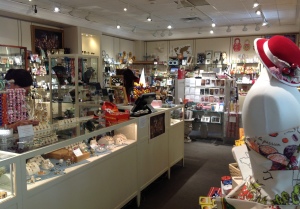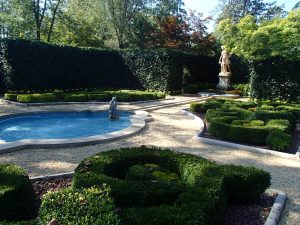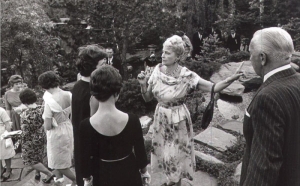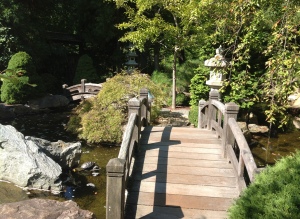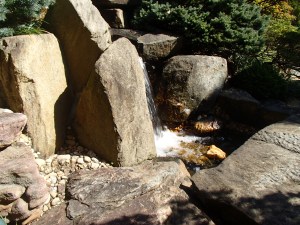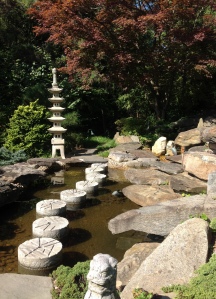Purchased by Marjorie Merriweather Post in 1955, following divorce from her third husband, Hillwood is located at 4155 Linnean Avenue in NW Washington, D.C. During her lifetime, Hillwood became a place to showcase her collections, particularly Russian imperial art, and became a legendary social venue.
Surrounding the Georgian mansion are several gardens: a cutting garden, a four seasons garden, a putting green, French parterre, lunar lawn, and a Japanese-style garden.
“She hired prominent landscape architects Umberto Innocenti and Richard Webel to expand the existing gardens,” the web site notes. “Thirteen acres of formal gardens extend from the house’s terraces and porches in a progression of outdoor rooms.” (from the Hillwood web site)
“Designed by Shogo Myaida and clearly reflecting Marjorie Post’s love of collecting decorative objects, this non-traditional Japanese garden offers action and intrigue instead of opportunities for contemplative meditation found in other Japanese gardens. ”
“Myaida began his career working in an architectural firm in New York and soon began to build a network of influential people who were able to help him to find bigger and better jobs. A friend at the New York Botanical Garden helped him to get a job rehabilitating the grounds of a girls college in Georgia. Later, he went to Florida and worked for several well known architects in Palm Beach, where he first met Marjorie Merriweather Post, the cereal heiress, whose magnificent homes in Palm Beach and Washington D.C. were legendary. Myaida went back to Long Island in 1926 where he worked for a large landscape contractor, creating and improving many private gardens.
“During the Great Depression he scraped by, gardening and, in the winter, selling manure for mulch and sharing rent and food with fellow workers. “For many days,” he remembered, “we had rice and a big iron pot full of split pea soup on a big old coal stove in the kitchen.”
“In 1938, recovered from the depression years, he supervised the landscape design for the New York World’s Fair Japanese Garden and was in charge of its maintenance during the run of the fair. He married his young American secretary and bookkeeper in 1941, “and shortly after Japanese started to fight with America. We had quite a time. The FBI came over and check all my house and everything I had and they said that as long as I stayed in Albertson (New York) I do not need to go to Ellis Island.” He found jobs working in greenhouses during the war, and “then when the war was over, and get freer so I started designing gardens all around again.
“In 1952, Myaida read in a newspaper that Japanese-born people could become American citizens, and he applied for and received American citizenship. Shortly afterward Mrs. Post’s landscape architect contacted him about doing a Japanese garden at Hillwood, Mrs. Post’s 25 acre estate in Washington D.C. Myaida modestly remembered that the garden was “quite good,” and then added, “supposed to be one of the best on the East Coast.” Today the estate is a museum and garden, open to the public, and Myaida’s beautiful garden is in the process of restoration.”
*Much of information in this article, and all of the direct quotes, are from the transcript of an interview conducted with Shogo Myaida on July 10, 1988 by Dorothy Rony, New York Chinatown History Project; Lorie Kitazano, Queens college, Asian History Studies; and Lily Y. Kiyasu, Garden City, New York.
(from “A Trunk Full of Stories” by the Japanese American National Museum)
Shogo Myaida papers are housed in the collection of the Japanese American National Museum in Los Angeles.
https://oac.cdlib.org/findaid/ark:/13030/kt9n39s11w/entire_text/

Ann Stevens photo from Hillwood: during restoration, all the stones were carefully mapped using GPS and marked before being removed
For more information, go to the estate web site or phone 202.686.5807.

